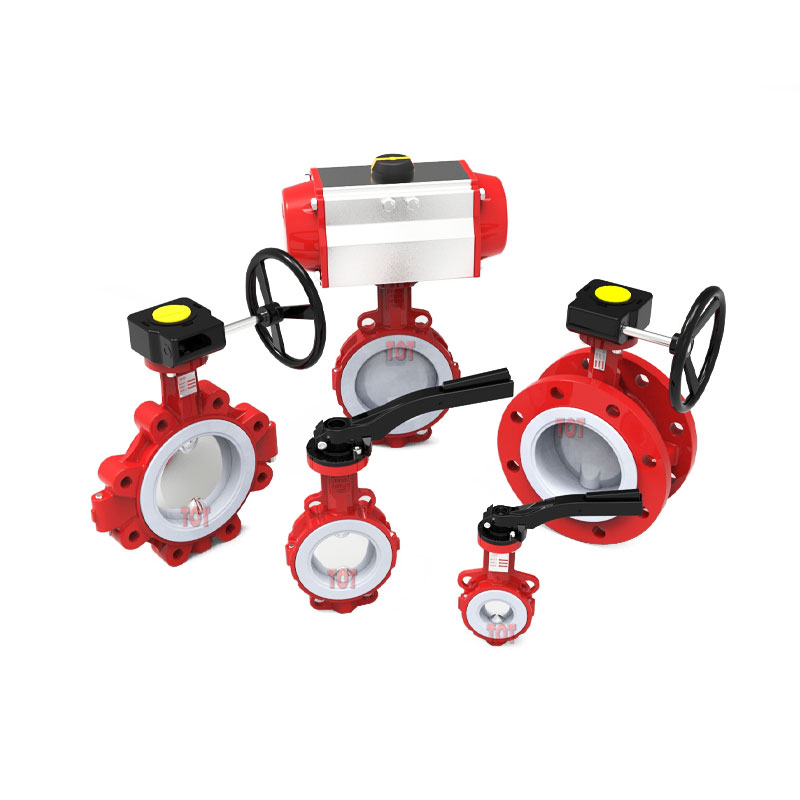Imagine you need to control the flow of water, gas, or slurry in a pipeline—quickly, efficiently, and without taking up too much space. That’s exactly where butterfly valves come into play. Known for their fast operation, compact design, and cost-effectiveness, butterfly valves are a go-to solution across a wide range of industries.

In this guide, you’ll learn what a butterfly valve is, how it works, the different types available, how it compares with other valve technologies, and how to choose the right one for your application.
Table of Contents
Toggle1. How a Butterfly Valve Works & Its Core Advantages
🔧 Working Principle
A butterfly valve regulates flow using a circular disc (the “butterfly”) mounted on a rotating shaft. Turning the actuator or handle rotates the disc 90 degrees, allowing it to:
Open fully (parallel to flow)
Close completely (perpendicular to flow)
Throttle flow by setting the disc at intermediate angles
This simple rotation allows for quick shutoff and reliable control in low- to medium-pressure systems.
✅ Core Advantages
| Feature | Benefit |
|---|---|
| Compact & Lightweight | Ideal for installations with limited space |
| Cost-Effective | Typically cheaper than ball or gate valves |
| Fast Operation | 90° rotation = quick open/close cycle |
| Low Pressure Drop | Minimal flow resistance when fully open |
| Easy Maintenance | Fewer parts, lower wear in many models |
| Versatile | Suitable for liquids, gases, and slurries |
2. Common Types of Butterfly Valves
Butterfly valves come in several configurations depending on their connection type and internal design.
🔗 By Connection Type
🔹 Wafer Butterfly Valve
Sandwiched between two flanges
Most common and economical design
Ideal for systems with minimal pressure spikes
[Explore: Wafer Butterfly Valves →]
🔹 Lug Butterfly Valve
Threaded inserts (lugs) allow bolt-to-flange installation
Can isolate one side of the pipeline
Useful in dead-end service
[Explore: Lug Butterfly Valves →]
🔹 Flanged Butterfly Valve
Has flanges on both ends for bolting to mating pipe flanges
More robust and easier to remove for maintenance
[Explore: Flanged Butterfly Valves →]
⚙️ By Disc Offset / Seating Design
🔸 Concentric (Zero Offset) Butterfly Valve
The disc and shaft share the same centerline
Cost-effective, used in low-pressure water and HVAC systems
🔸 Double Offset Butterfly Valve
Shaft is offset from disc center and valve body
Reduces friction during opening/closing
Used in industrial water, chemical, and power systems
[Explore: Double Offset Valves →]
🔸 Triple Offset Butterfly Valve
Adds a third offset (seating geometry)
No rubbing between disc and seat = high durability
Ideal for high-temperature, high-pressure, or tight shutoff conditions
[Explore: Triple Offset Valves →]
3. Butterfly Valves vs. Other Valve Types
🔁 Butterfly Valve vs. Ball Valve
| Feature | Butterfly Valve | Ball Valve |
|---|---|---|
| Cost | Lower | Higher |
| Size & Weight | Lighter, more compact | Bulkier |
| Flow Control | Good for throttling | Poor throttling, on/off use |
| Sealing | Moderate to high (depending on type) | Excellent |
| Applications | Water, HVAC, slurry, gas | Oil, gas, water |
👉 Choose a butterfly valve when you need space-saving, cost-effective flow control.
👉 Choose a ball valve for high-sealing performance in clean media.
🔁 Butterfly Valve vs. Gate Valve
| Feature | Butterfly Valve | Gate Valve |
|---|---|---|
| Operation Speed | Fast (90° turn) | Slow (multi-turn) |
| Installation Space | Compact | Requires more space |
| Flow Control | Better throttling | Poor throttling |
| Weight | Lightweight | Heavier |
| Cost | Lower | Higher |
👉 Use a butterfly valve for compact systems with fast operation.
👉 Use a gate valve where infrequent operation and tight shutoff are needed.
4. How to Choose the Right Butterfly Valve
Here’s a practical checklist to guide your selection:
✅ Selection Factors
Size: Match the valve diameter to the pipeline (e.g., 4 inch butterfly valve)
Material: Choose based on media—e.g., stainless steel for corrosive fluids
Pressure Rating: Ensure the valve can handle system pressure (e.g., PN16, Class 150)
Connection Type: Wafer, lug, or flanged?
Seat Material: EPDM, PTFE, metal, etc.
Disc Design: Concentric, double offset, or triple offset?
Actuation: Manual, electric, pneumatic, or gear-operated?
👉 Need help? Visit our guides on:
5. Brands & Suppliers: Who Makes Reliable Butterfly Valves?
Here are some well-known global butterfly valve manufacturers:
| Brand | Key Features |
|---|---|
| Bray | High-performance valves for industrial use |
| Victaulic | Known for grooved-end valves and quick coupling |
| Keystone (Emerson) | Offers resilient and high-performance valves |
| NIBCO | American-made valves for plumbing and HVAC |
| DeZURIK | Specializes in slurry, wastewater, and pulp & paper valves |
👉 Learn more: [Compare Butterfly Valve Brands →]
Note: This is not a product endorsement. Always match specifications to your system requirements.
Conclusion
Butterfly valves offer a powerful balance of performance, simplicity, and cost-effectiveness. Whether you’re dealing with clean water, aggressive chemicals, or abrasive slurry, there’s a butterfly valve designed to meet your needs.
Understanding the differences between valve types and configurations will help you select the right solution—improving efficiency, reducing maintenance, and ensuring long-term system reliability.
Ready to choose the right butterfly valve? Explore our product guides or contact our experts for tailored support.
